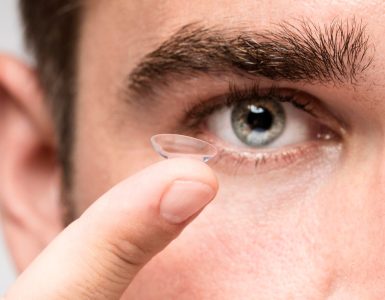While some of us try to stave off the physical effects of aging, gradually losing our ability to focus on nearby objects is a natural part of the aging process that happens to us all. This is known as presbyopia.
What are the symptoms?
Usually starting around the age of 40 you may notice that you are struggling to see small print clearly, including text messages on your phone, or when doing close-up work. Here are a few signs that you may be experiencing presbyopia:
- When you hold a book at normal distance your vision is blurry. You find you need to hold it further away in order to read it.
- Difficulty reading or doing close work in poor light. You may now need brighter lighting in order to do this.
- You experience headaches or eye strain after reading or doing close work because of the strain of focussing your eyes.
Often you may notice that these symptoms are worse when you are tired.
What causes presbyopia?
In order for you to be able to see light passes through the lens of your eye to the retina at the back of your eye. A normal healthy lens changes shape so it can bend the light rays to focus them onto the retina. When you are young, your lens is flexible and quite elastic. Tiny muscles that circle the lens can help it change its length and shape allowing you to focus on both close and distant objects.
As you get older, your lens loses that flexibility and begins to harden so it can no longer change shape gradually losing its ability to focus directly onto the retina and as a consequence, its ability to focus on close images.
What are the risk factors for presbyopia?
The greatest risk factor for presbyopia is age with most people experiencing some loss of the ability to focus on close objects after the age of 40. However, in some instances people younger than 40 can experience the symptoms of presbyopia. Some underlying medical conditions, such as anaemia, diabetes, cardiovascular disease, multiple sclerosis and myasthenia gravis, can cause you to be at higher risk of premature presbyopia. Certain drugs, such as antidepressants, antihistamines and diuretics can also be associated with symptoms of premature presbyopia.
How is presbyopia diagnosed and treated?
If you are having symptoms of presbyopia, it is recommended that you consult your optometrist and have a full eye examination. It is wise as we get older to also have our eyes examined for the presence of any eye disease or vision disorders that may begin to develop around this time.
Although there is no cure for presbyopia, there are several treatment methods available that will help to correct your vision.
- Non-prescription glasses. If you don’t have any other vision problems, you may find over-the-counter reading glasses will suit you. These are available through your local pharmacy. It is important to test the different degrees of magnification until you find the one that suits you. It is recommended that you choose the lowest magnification that allows you to read comfortably.
- Prescription glasses. You may choose to ask your optometrist for prescription glasses for use while reading. If you have other vision problems that require corrective lenses, there are options available that will rectify both your distance and close-up vision, such as bifocals and progressive multifocal lenses. Progressive lenses are the most popular solution as they allow have multiple powers that correct distance, middle distance and close-up.
- Contact lenses. If you don’t wish to wear glasses, then there are contact lenses that are able to improve vision problems caused by presbyopia. Bifocal contact lenses provide distance and close-up correction on each contact. With monovision contact lenses, one contact lens is set to your distance vision, while the lens for your other eye is set for close-up vision. There is also the option of modified monovision contact lenses. In this instance you would wear a bifocal lens in one eye, set for reading and distance vision, and the other eye set to distance vision only.
- Surgery. There are several refractive surgeries available that involve the reshaping of the cornea. There is also the option of a lens implant (replacing the lens with a synthetic lens), or a cornel implant. You will need to discuss with your ophthalmologist about the various procedures, any possible side effects and risks. Most procedures are non-reversible.
Whilst we can’t reverse the aging of our eye that causes presbyopia, we can ensure it has as little impact on our day-to-day lives as possible. The good news is that the vision lost to presbyopia can be corrected whatever method of treatment you choose.
In the meantime, make sure you protect you vision by getting regular eye examinations, control any health conditions such as diabetes and high blood pressure that could contribute to loss of vision, make sure you wear sunglasses outside, wear protective glasses when undertaking any activities that could potentially cause eye injury, keep your eye prescription up-to-date, read in good light and most of all eat a healthy diet full of foods containing antioxidants, vitamin A and beta carotene.




